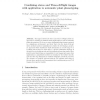Free Online Productivity Tools
i2Speak
i2Symbol
i2OCR
iTex2Img
iWeb2Print
iWeb2Shot
i2Type
iPdf2Split
iPdf2Merge
i2Bopomofo
i2Arabic
i2Style
i2Image
i2PDF
iLatex2Rtf
Sci2ools
218
Voted
SCIA
2011
Springer
2011
Springer
Combining Stereo and Time-of-Flight Images with Application to Automatic Plant Phenotyping
Abstract. This paper shows how stereo and Time-of-Flight (ToF) images can be combined to estimate dense depth maps in order to automate plant phenotyping. We focus on some challenging plant images captured in a glasshouse environment, and show that even the state-of-the-art stereo methods produce unsatisfactory results. By developing a geometric approach which transforms depth information in a ToF image to a localised search range for dense stereo, a global optimisation strategy is adopted for producing smooth and discontinuity-preserving results. Since pixel-by-pixel depth data are unavailable for our images and many other applications, a quantitative method accounting for the surface smoothness and the edge sharpness to evaluate estimation results is proposed. We compare our method with and without ToF against other state-ofthe-art stereo methods, and demonstrate that combining stereo and ToF images gives superior results.
| Added | 17 Sep 2011 |
| Updated | 17 Sep 2011 |
| Type | Journal |
| Year | 2011 |
| Where | SCIA |
| Authors | Yu Song, Chris A. Glasbey, Gerie W. A. M. van der Heijden, Gerrit Polder, J. Anja Dieleman |
Comments (0)

